Amana M-H-S-8, D-H-S8, HS8, GME8 User Manual
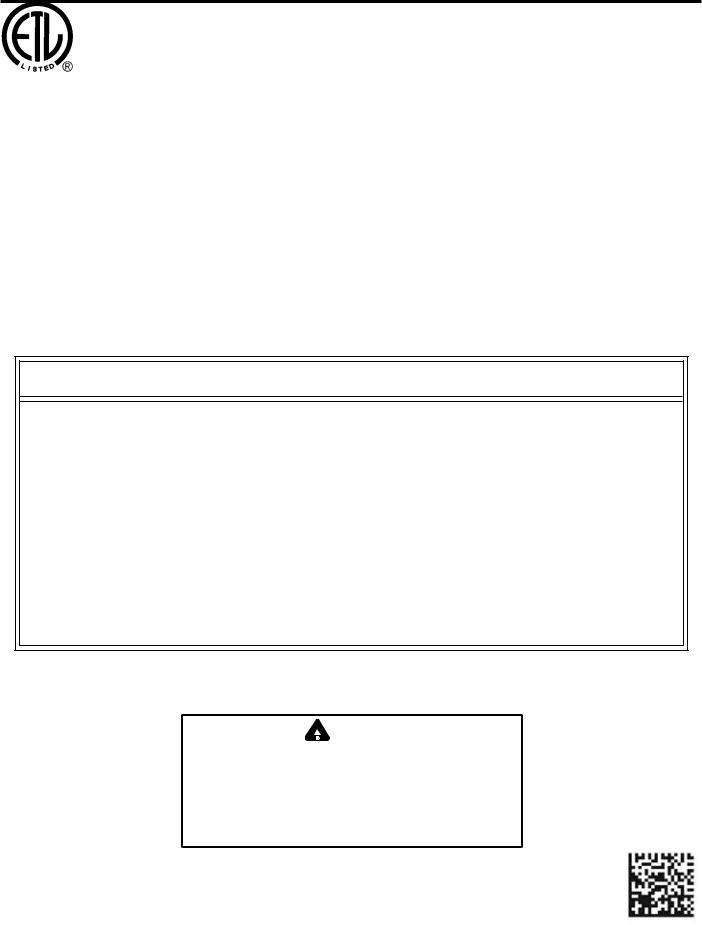
INSTALLATION INSTRUCTIONS FOR *M(H,S)8 / *D(H,S)8 / *HS8 / GME8 GAS FURNACE
(CATEGORY I )
Installer: Affix all manuals adjacent to the unit.
These furnaces comply with requirements em- |
|
|
|
|
bodied in the American National Standard / Na- |
|
® |
|
|
tional Standard of Canada ANSI Z21.47·CSA- |
|
|
|
|
2.3 Gas Fired Central Furnaces. |
C |
|
|
US |
|
|
|||
|
|
|
|
|
|
|
|
|
|
 RECOGNIZE THIS SYMBOL AS A SAFETY PRECAUTION.
RECOGNIZE THIS SYMBOL AS A SAFETY PRECAUTION.
ATTENTION INSTALLING PERSONNEL
As a professional installer, you have an obligation to know the product better than the customer. This includes all safety precautions and related items.
Prior to actual installation, thoroughly familiarize yourself with this Instruction Manual.
Pay special attention to all safety warnings. Often during installation or repair, it is possible to place yourself in a position which is more hazardous than when the unit is in operation.
Remember, it is your responsibility to install the product safely and to know it well enough to be able to instruct a customer in its safe use.
Safety is a matter of common sense...a matter of thinking before acting. Most dealers have a list of specific, good safety practices...follow them.
The precautions listed in this Installation Manual are intended as supplemental to existing practices. However, if there is a direct conflict between existing practices and the content of this manual,
the precautions listed here take precedence.
NOTE: Please contact your distributor or our website listed below for the applicable Specification Sheet referred to in this manual.
 WARNING
WARNING
GOODMAN WILL NOT BE RESPONSIBLE FOR ANY INJURY OR PROPERTY
DAMAGE ARISING FROM IMPROPER SERVICE OR SERVICE PROCEDURES.
IF YOU INSTALL OR PERFORM SERVICE ON THIS UNIT, YOU ASSUME
RESPONSIBILITY FOR ANY PERSONAL INJURY OR PROPERTY DAMAGE
WHICH MAY RESULT. MANY JURISDICTIONS REQUIRE A LICENSE TO
INSTALL OR SERVICE HEATING AND AIR CONDITIONING EQUIPMENT.
5151 San Felipe Suite 500 • Houston, TX 77056
IO-417A |
www.goodmanmfg.com • www.amana-hac.com |
11/2011 |
© 2011 Goodman Manufacturing Company, L.P. |
Table of Contents |
|
ADDITIONAL SAFETY CONSIDERATIONS ...................................................................................................... |
6 |
SHIPPING INSPECTION ........................................................................................................................... |
6 |
ELECTROSTATIC DISCHARGE (ESD) PRECAUTIONS ..................................................................................... |
6 |
TO THE INSTALLER .............................................................................................................................. |
6 |
IMPORTANT NOTE TO THE OWNER REGARDING PRODUCT WARRANTY................................................................. |
6 |
PRODUCT APPLICATION ............................................................................................................................... |
7 |
LOCATION REQUIREMENTS AND CONSIDERATIONS ................................................................................................ |
8 |
CLEARANCES AND ACCESSIBILITY ............................................................................................................ |
9 |
INSTALLATION POSITIONS ...................................................................................................................... |
9 |
HORIZONTAL INSTALLATION .................................................................................................................... |
9 |
FURNACE SUSPENSION .......................................................................................................................... |
9 |
EXISTING FURNACE REMOVAL .............................................................................................................. |
10 |
THERMOSTAT LOCATION ...................................................................................................................... |
10 |
COMBUSTION AND VENTILATION AIR REQUIREMENTS .......................................................................................... |
10 |
CATEGORY I VENTING (VERTICAL VENTING) ..................................................................................................... |
11 |
EXTERIOR MASONRY CHIMNEYS (CATEGORY I FURNACES ONLY) ......................................................................... |
12 |
CHECKLIST SUMMARY ........................................................................................................................ |
12 |
CHECK 1 - PROPER CHIMNEY TERMINATION. ............................................................................................. |
13 |
CHECK 2 -ANY SOLID OR LIQUID FUEL APPLIANCES VENTED INTO THIS CHIMNEY CHANNEL ...................................... |
13 |
CHECK 3 - CHIMNEY CROWN CONDITION................................................................................................. |
14 |
CHECK 4 - DEBRIS IN CLEANOUT .......................................................................................................... |
14 |
CHECK 5 - LINER CONDITION................................................................................................................ |
14 |
CHECK 6 - DILUTION AIR. ................................................................................................................... |
14 |
CHECK 7 - COMPLETE THE INSTALLATION. ............................................................................................... |
15 |
FIX 1 - LINER TERMINATION ................................................................................................................. |
15 |
FIX 2 -CHANGE VENTING ARRANGEMENTS ............................................................................................... |
15 |
FIX 3 - REBUILD THE CROWN ............................................................................................................... |
15 |
FIX 4 - RELINING .............................................................................................................................. |
15 |
ELECTRICAL CONNECTIONS ........................................................................................................................ |
16 |
WIRING HARNESS .............................................................................................................................. |
16 |
115 VOLT LINE CONNECTIONS ............................................................................................................. |
16 |
FOSSIL FUEL APPLICATIONS ................................................................................................................ |
16 |
JUNCTION BOX RELOCATION ................................................................................................................ |
17 |
24 VOLT THERMOSTAT WIRING ............................................................................................................ |
17 |
GME8 FURNACE WITH 2-STAGE CONDENSER FIELD WIRING ....................................................................... |
17 |
SETTING THE HEAT ANTICIPATOR ........................................................................................................... |
18 |
115 VOLT LINE CONNECTION OF ACCESSORIES ........................................................................................ |
18 |
(ELECTRONIC AIR CLEANER) ................................................................................................................ |
18 |
24 VAC HUMIDIFIER .......................................................................................................................... |
19 |
GAS SUPPLY AND PIPING ........................................................................................................................... |
19 |
HIGH ALTITUDE DERATE ...................................................................................................................... |
19 |
PROPANE GAS CONVERSION ................................................................................................................ |
19 |
GAS PIPING CONNECTIONS .................................................................................................................. |
20 |
UPFLOW INSTALLATIONS ..................................................................................................................... |
20 |
COUNTERFLOW INSTALLATIONS .............................................................................................................. |
21 |
GAS PIPING CHECKS ......................................................................................................................... |
21 |
PROPANE GAS TANKS AND PIPING ......................................................................................................... |
21 |
2
Table of Contents |
|
CIRCULATING AIR AND FILTERS .................................................................................................................... |
22 |
DUCTWORK - AIR FLOW ...................................................................................................................... |
22 |
CHECKING DUCT STATIC ..................................................................................................................... |
22 |
FILTERS - READ THIS SECTION BEFORE INSTALLING THE RETURN AIR DUCTWORK ............................................ |
23 |
UPRIGHT INSTALLATIONS ..................................................................................................................... |
23 |
CIRCULATION AIR FILTERS ................................................................................................................... |
23 |
HORIZONTAL INSTALLATIONS ................................................................................................................ |
23 |
SEQUENCE OF OPERATION (INTEGRATED IGNITION CONTROL) ................................................................................ |
23 |
POWER UP ...................................................................................................................................... |
23 |
HEATING MODE ................................................................................................................................. |
24 |
(MODE DIP SWITCH IS SET TO “1 STG” POSITION) .................................................................................. |
24 |
(MODE DIP SWITCH IS SET TO “2 STG” POSITION) ................................................................................. |
24 |
COOLING MODE ................................................................................................................................ |
24 |
FAN ONLY MODE .............................................................................................................................. |
25 |
START-UP PROCEDURE AND ADJUSTMENT ....................................................................................................... |
25 |
FURNACE OPERATION .......................................................................................................................... |
25 |
FURNACE START-UP ........................................................................................................................... |
25 |
FURNACE SHUTDOWN ......................................................................................................................... |
25 |
GAS SUPPLY PRESSURE MEASUREMENT .................................................................................................. |
25 |
GAS MANIFOLD PRESSURE MEASUREMENT AND ADJUSTMENT ....................................................................... |
28 |
GAS INPUT RATE MEASUREMENT (NATURAL GAS ONLY) ............................................................................ |
29 |
TEMPERATURE RISE ........................................................................................................................... |
29 |
CIRCULATOR BLOWER SPEED ADJUSTMENT ............................................................................................. |
30 |
CIRCULATOR BLOWER FAN TIMING ADJUSTMENT ...................................................................................... |
30 |
SETTING FURNACE OPERATING MODE (*DH8, *ME8, AND *MH8 MODELS ONLY) ............................................ |
30 |
OPERATIONAL CHECKS .............................................................................................................................. |
31 |
BURNER FLAME ................................................................................................................................ |
31 |
AUXILIARY LIMIT CONTROL ................................................................................................................. |
31 |
SAFETY CIRCUIT DESCRIPTION .................................................................................................................... |
31 |
GENERAL ......................................................................................................................................... |
31 |
INTEGRATED CONTROL MODULE ............................................................................................................. |
31 |
PRIMARY LIMIT ................................................................................................................................ |
31 |
AUXILIARY LIMIT ............................................................................................................................... |
31 |
ROLLOUT LIMITS .............................................................................................................................. |
32 |
PRESSURE SWITCHES ......................................................................................................................... |
32 |
FLAME SENSOR ................................................................................................................................ |
32 |
TROUBLESHOOTING ................................................................................................................................... |
32 |
ELECTROSTATIC DISCHARGE (ESD) PRECAUTIONS ................................................................................... |
32 |
DIAGNOSTIC CHART........................................................................................................................... |
32 |
FAULT RECALL ................................................................................................................................ |
32 |
RESETTING FROM LOCKOUT ................................................................................................................ |
32 |
3
Table of Contents |
|
MAINTENANCE ......................................................................................................................................... |
32 |
ANNUAL INSPECTION ........................................................................................................................... |
33 |
FILTERS .......................................................................................................................................... |
33 |
FILTER MAINTENANCE ......................................................................................................................... |
33 |
FILTER REMOVAL .............................................................................................................................. |
33 |
INDUCED DRAFT AND CIRCULATOR BLOWER MOTORS ................................................................................. |
33 |
FLAME SENSOR (QUALIFIED SERVICER ONLY) .......................................................................................... |
33 |
IGNITER (QUALIFIED SERVICER ONLY) ..................................................................................................... |
33 |
BURNERS ......................................................................................................................................... |
33 |
CLEANING (QUALIFIED SERVICER ONLY) ........................................................................................................ |
34 |
BEFORE LEAVING AN INSTALLATION ............................................................................................................... |
34 |
REPAIR AND REPLACEMENT PARTS .............................................................................................................. |
34 |
COMPONENT IDENTIFICATION ................................................................................................................. |
35 - 36 |
APPENDIX......................................................................................................................................... |
37 |
TROUBLESHOOTING CHART .................................................................................................................. |
37 |
BLOWER PERFORMANCE DATA ............................................................................................................. |
40 |
*M(H/S)8 ................................................................................................................................. |
40 |
*(D/H)S8 ................................................................................................................................. |
41 |
GME8 ..................................................................................................................................... |
42 |
*(M, D, H)S8 WIRING DIAGRAM .................................................................................................. |
43 |
GME8 WIRING DIAGRAM ............................................................................................................ |
44 |
*(M,D)H* WIRING DIAGRAM...................................................................................................................... |
45 |
4
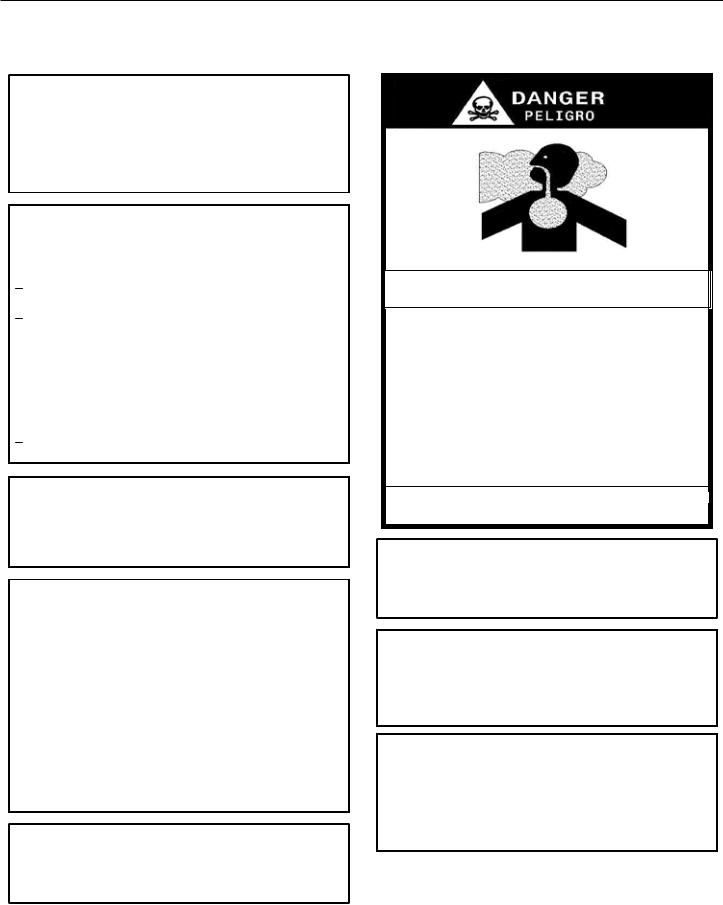
SAFETY PRECAUTIONS
Adhere to the following warnings and cautions when installing, adjusting, altering, servicing, or operating the furnace. To ensure proper installation and operation, thoroughly read this manual for specifics pertaining to the installation and application of this product.
 WARNING
WARNING
TO PREVENT PERSONAL INJURY OR DEATH DUE TO IMPROPER INSTALLATION, ADJUSTMENT, ALTERATION, SERVICE OR MAINTENANCE,
REFER TO THIS MANUAL. FOR ADDITIONAL ASSISTANCE OR INFORMATION, CONSULT A QUALIFIED INSTALLER, SERVICER AGENCY OR THE GAS SUPPLIER.
 WARNING
WARNING
IF THE INFORMATION IN THESE INSTRUCTIONS IS NOT FOLLOWED EXACTLY, A FIRE OR EXPLOSION MAY RESULT CAUSING PROPERTY DAMAGE, PERSONAL INJURY OR LOSS OF LIFE.
DO NOT STORE OR USE GASOLINE OR OTHER FLAMMABLE VAPORS AND LIQUIDS IN THE VICINITY OF THIS OR ANY OTHER APPLIANCE.
WHAT TO DO IF YOU SMELL GAS:
DO NOT TRY TO LIGHT ANY APPLIANCE.
DO NOT TOUCH ANY ELECTRICAL SWITCH; DO NOT USE ANY PHONE IN YOUR BUILDING.
IMMEDIATELY CALL YOUR GAS SUPPLIER FROM A NEIGHBOR’S PHONE. FOLLOW THE GAS SUPPLIER’S INSTRUCTIONS.
IF YOU CANNOT REACH YOUR GAS SUPPLIER, CALL THE FIRE DEPARTMENT.
INSTALLATION AND SERVICE MUST BE PERFORMED BY A QUALIFIED INSTALLER, SERVICE AGENCY OR THE GAS SUPPLIER.
 WARNING
WARNING
THIS PRODUCT CONTAINS OR PRODUCES A CHEMICAL OR CHEMICALS WHICH MAY CAUSE SERIOUS ILLNESS OR DEATH AND WHICH ARE KNOWN TO THE STATE OF CALIFORNIA TO CAUSE CANCER, BIRTH DEFECTS OR OTHER REPRODUCTIVE HARM.
 WARNING
WARNING
HEATING UNIT SHOULD NOT BE UTILIZED WITHOUT REASONABLE,
ROUTINE, INSPECTION, MAINTENANCE AND SUPERVISION. IF THE BUILDING IN WHICH ANY SUCH DEVICE IS LOCATED WILL BE VACANT,
CARE SHOULD BE TAKEN THAT SUCH DEVICE IS ROUTINELY INSPECTED,
MAINTAINED AND MONITORED. IN THE EVENT THAT THE BUILDING MAYBE EXPOSED TO FREEZING TEMPERATURES AND WILL BE VACANT,
ALL WATER BEARING PIPES SHOULD BE DRAINED, THE BUILDING SHOULD BE PROPERLY WINTERIZED, AND THE WATER SOURCE CLOSED. IN THE EVENT THAT THE BUILDING MAY BE EXPOSED TO FREEZING TEMPERATURES AND WILL BE VACANT, ANY HYDRONIC COIL UNITS SHOULD BE DRAINED AS WELL AND, IN SUCH CASE, ALTERNATIVE HEAT SOURCES SHOULD BE UTILIZED.
 WARNING
WARNING
CARBON MONOXIDE POISONING HAZARD
Special Warning for Installation of Furnace or Air Handling Units in Enclosed Areas such as Garages, Utility Rooms or Parking Areas
Carbon monoxide producing devices (such as an automobile, space heater, gas water heater, etc.) should not be operated in enclosed areas such as unventilated garages, utility rooms or parking areas because of the danger of carbon monoxide (CO) poisoning resulting from the exhaust emissions. If a furnace or air handler is installed in an enclosed area such
as a garage, utility room or parking area and a carbon monoxide producing device is operated therein, there must be adequate, direct outside ventilation.
This ventilation is necessary to avoid the danger of CO poisoning which can occur if a carbon monoxide producing device continues to operate in the enclosed area. Carbon monoxide emissions can be (re)circulated
throughout the structure if the furnace or air handler is operating in any mode.
CO can cause serious illness including permanent brain damage or death.
B10259--216
 WARNING
WARNING
SHOULD OVERHEATING OCCUR OR THE GAS SUPPLY FAIL TO SHUT OFF, TURN OFF THE MANUAL GAS SHUTOFF VALVE EXTERNAL TO THE FURNACE BEFORE TURNING OFF THE ELECTRICAL SUPPLY.
 WARNING
WARNING
POSSIBLE PROPERTY DAMAGE, PERSONAL INJURY OR DEATH DUE TO FIRE, EXPLOSION, SMOKE, SOOT, CONDENSATION, ELECTRICAL SHOCK OR CARBON MONOXIDE MAY RESULT FROM IMPROPER INSTALLATION,
REPAIR OPERATION, OR MAINTENANCE OF THIS PRODUCT.
 WARNING
WARNING
TO PREVENT PERSONAL INJURY OR DEATH DUE TO IMPROPER INSTALLATION, ADJUSTMENT, ALTERATION, SERVICE OR MAINTENANCE,
REFER TO THIS MANUAL. FOR ADDITIONAL ASSISTANCE OR INFORMATION, CONSULT A QUALIFIED INSTALLER, SERVICER AGENCY OR THE GAS SUPPLIER.
TO PREVENT POSSIBLE PROPERTY DAMAGE, PERSONAL INJURY OR DEATH DUE TO ELECTRICAL SHOCK, THE FURNACE MUST BE LOCATED TO PROTECT THE ELECTRICAL COMPONENTS FROM WATER.
5
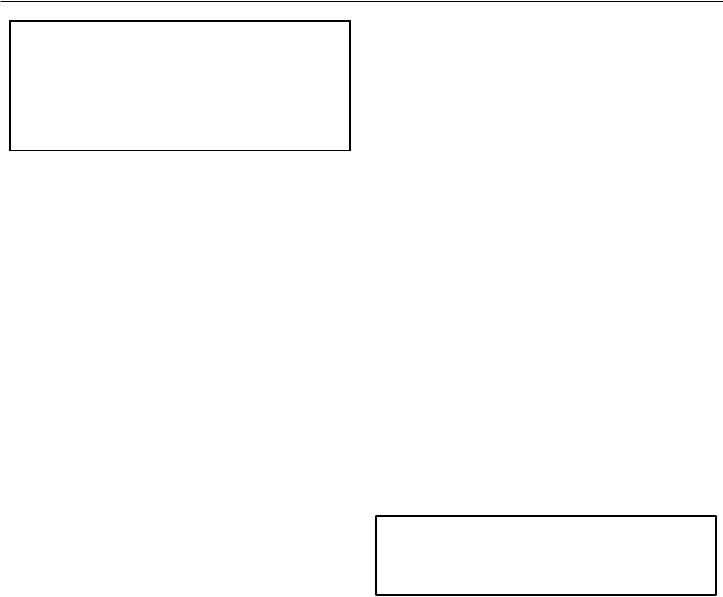
SAFETY PRECAUTIONS
 WARNING
WARNING
TO PREVENT PERSONAL INJURY OR DEATH DUE TO ASPHYXIATION, THIS FURNACE MUST BE CATEGORY I VENTED. DO NOT VENT USING
CATEGORY III VENTING.
PROVISIONS MUST BE MADE FOR VENTING COMBUSTION PRODUCTS OUTDOORS THROUGH A PROPER VENTING SYSTEM. THE LENGTH OF FLUE PIPE COULD BE A LIMITING FACTOR IN LOCATING THE FURNACE.
ADDITIONAL SAFETY CONSIDERATIONS
•This furnace is approved for Category I Venting only.
•Provisions must be made for venting combustion products outdoors through a proper venting system. The length of flue pipe could be a limiting factor in locating the furnace.
SHIPPINGINSPECTION
All units are securely packed in shipping containers tested according to International Safe Transit Association specifications. The carton must be checked upon arrival for external damage. If damage is found, a request for inspection by carrier’s agent must be made in writing immediately.
The furnace must be carefully inspected on arrival for damage and bolts or screws which may have come loose in transit. In the event of damage the consignee should:
1.Make a notation on delivery receipt of any visible damage to shipment or container.
2.Notify carrier promptly and request an inspection.
3.With concealed damage, carrier must be notified as soon as possible - preferably within five days.
4.File the claim with the following support documents within a nine month statute of limitations.
•Original or certified copy of the Bill of Lading, or indemnity bond.
•Original paid freight bill or indemnity in lieu thereof.
•Original or certified copy of the invoice, showing trade and other discounts or reductions.
•Copy of the inspection report issued by carrier’s representative at the time damage is reported to carrier.
The carrier is responsible for making prompt inspection of damage and for a thorough investigation of each claim. The distributor or manufacturer will not accept claims from dealers for transportation damage.
Keep this literature in a safe place for future reference.
ELECTROSTATIC DISCHARGE (ESD)PRECAUTIONS
NOTE: Discharge body’s static electricity before touching unit. An electrostatic discharge can adversely affect electrical components.
Use the following precautions during furnace installation and servicing to protect the integrated control module from damage. By putting the furnace, the control, and the person at the same electrostatic potential, these steps will help avoid expos-
ing the integrated control module to electrostatic discharge. This procedure is applicable to both installed and non-installed (ungrounded) furnaces.
1.Disconnect all power to the furnace. Do not touch the integrated control module or any wire connected to the control prior to discharging your body’s electrostatic charge to ground.
2.Firmly touch a clean, unpainted, metal surface of the furnaces near the control. Any tools held in a person’s hand during grounding will be discharged.
3.Service integrated control module or connecting wiring following the discharge process in step 2. Use caution not to recharge your body with static electricity; (i.e., do not move or shuffle your feet, do not touch ungrounded objects, etc.). If you come in contact with an ungrounded object, repeat step 2 before touching control or wires.
4.Discharge your body to ground before removing a new control from its container. Follow steps 1 through 3 if installing the control on a furnace. Return any old or new controls to their containers before touching any ungrounded object.
TO THE INSTALLER
Before installing this unit, please read this manual thoroughly to familiarize yourself with specific items which must be adhered to, including but not limited to: unit maximum external static pressure, gas pressures, BTU input rating, proper electrical connections, circulating air temperature rise, minimum or maximum CFM, and motor speed connections, and venting. These furnaces are designed for Category I venting only.
 WARNING
WARNING
TO PREVENT PROPERTY DAMAGE, PERSONAL INJURY OR DEATH DUE TO FIRE, DO NOT INSTALL THIS FURNACE IN A MOBILE HOME, TRAILER, OR RECREATIONAL VEHICLE.
IMPORTANT NOTE TO THE OWNER REGARDING PRODUCT
WARRANTY
Your warranty certificate is supplied as a separate document with the unit installed by your contractor. Read the limited warranty certificate carefully to determine what is and is not covered and keep the warranty certificate in a safe place. If you are unable to locate the warranty certificate please contact your installing contractor or contact customer service (877-254-4729) to obtain a copy.
IMPORTANT: To receive the Lifetime Heat Exchanger Limited Warranty (good for as long as you own your home) and the 10year Parts Limited Warranty, online registration must be completed within 60 days of installation. Online registration is not required in California or Quebec. Complete warranty details available from your local dealer or, for Goodman® brand products, visit www.goodmanmfg.com, and for Amana® brand products, visit www.amana-hac.com.
6
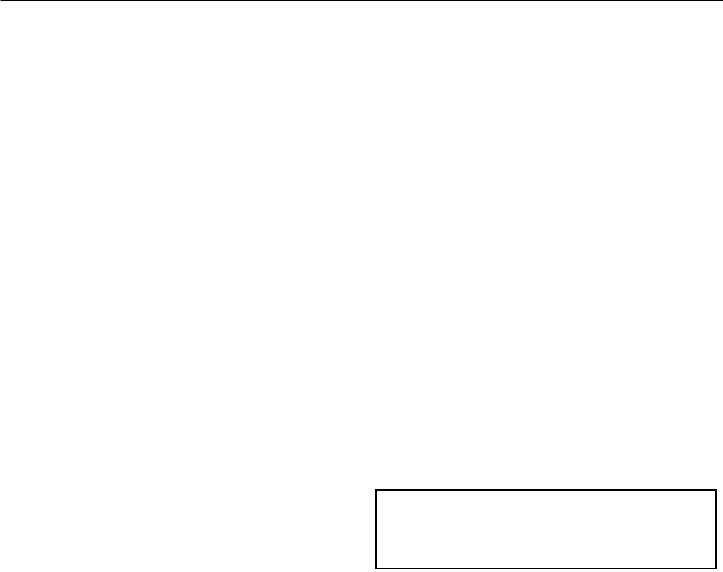
PRODUCT APPLICATION
To register your Goodman® brand unit, go to www.goodmanmfg.com and click “Warranty Registration”. Complete the registration as prompted.
To register your Amana® brand unit, go to www.amana-hac.com and click “Warranty Registration”. Complete the registration as prompted.
Product limited warranty certificates for models currently in production can be viewed at www.goodmanmfg.com or www.amanahac.com. If your model is not currently in production or does not appear on the website, please contact your installing contractor or contact customer service (877-254-4729) to obtain a copy of your warranty certificate.
Each product overview page contains a Product Warranty link; by clicking on it you will be able to view the limited warranty coverage for that specific product. To view warranty registration information, click on the Product Warranty text on the left navigation panel on the home page of each website. The Online Product Registration pages are located in this same section.
PRODUCT APPLICATION
•Air filters are installed in the system and maintained during construction, replaced as appropriate during construction, and upon completion of construction are replaced.
•The input rate and temperature rise are set per the furnace rating plate.
•100% outside air is provided for combustion air requirements during construction. Temporary ducting can be used.
NOTE: Do not connect the temporary duct directly to the furnace. The duct must be sized according to the instructions under Combustion and Ventilation Air Requirements, Section 5.3.3.
•The furnace heat exchanger, components, duct system, air filters and evaporator coils are thoroughly cleaned following final construction clean up.
•All furnace operating conditions (including ignition, input rate, temperature rise and venting) are verified according to these installation instructions.
NOTE: The Commonwealth of Massachusetts requires that the following additional requirements must also be met:
This furnace is primarily designed for residential home-heating applications. It is NOT designed or certified for use in mobile homes, trailers or recreational vehicles. Neither is it designed or certified for outdoor applications. The furnace must be installed indoors (i.e., attic space, crawl space, or garage area provided the garage area is enclosed with an operating door).
This furnace can be used in the following non-industrial commercial applications:
Schools,Officebuildings,Churches,Retailstores,
Nursinghomes,Hotels/motels,Commonorofficeareas
In such applications , the furnace must be installed with the following stipulations:
•It must be installed per the installation instructions provided and per local and national codes.
•It must be installed indoors in a building constructed on site.
•Gas furnaces must be installed by a licensed plumber or gas fitter.
•A T-handle gas cock must be used.
•If the unit is to be installed in an attic, the passageway to and the service area around the unit must have flooring.
 WARNING
WARNING
TO PREVENT PROPERTY DAMAGE, PERSONAL INJURY OR DEATH DUE TO FIRE, DO NOT INSTALL THIS FURNACE IN A MOBILE HOME, TRAILER, OR RECREATIONAL VEHICLE.
To ensure proper furnace operation, install, operate and maintain the furnace in accordance with these installation and operation instructions, all local building codes and ordinances. In their absence, follow the latest edition of the National Fuel Gas Code (NFPA 54/ANSI Z223.1), and/or
•It must be part of a ducted system and not used in a CAN/CSA B149 Installation Codes, local plumbing or waste
free air delivery application.
•It must not be used as a “make-up” air unit.
•All other warranty exclusions and restrictions apply.
This furnace may be used as a construction site heater ONLY if the following conditions are met:
•The vent system is permanently installed per these installation instructions.
•A room thermostat is used to control the furnace. Fixed jumpers that provide continuous heating CANNOT be used.
•Return air ducts are provided and sealed to the furnace.
•A return air temperature range between 60ºF (16ºC) and 80ºF (27ºC) is maintained.
water codes, and other applicable codes.
A copy of the National Fuel Gas Code (NFPA 54/ANSI Z223.1) can be obtained from any of the following:
American National Standards Institute
1430 Broadway
New York, NY 10018
National Fire Protection Association
1 Batterymarch Park
Quincy, MA 02269
CSA International
8501 East Pleasant Valley
Cleveland, OH 44131
7
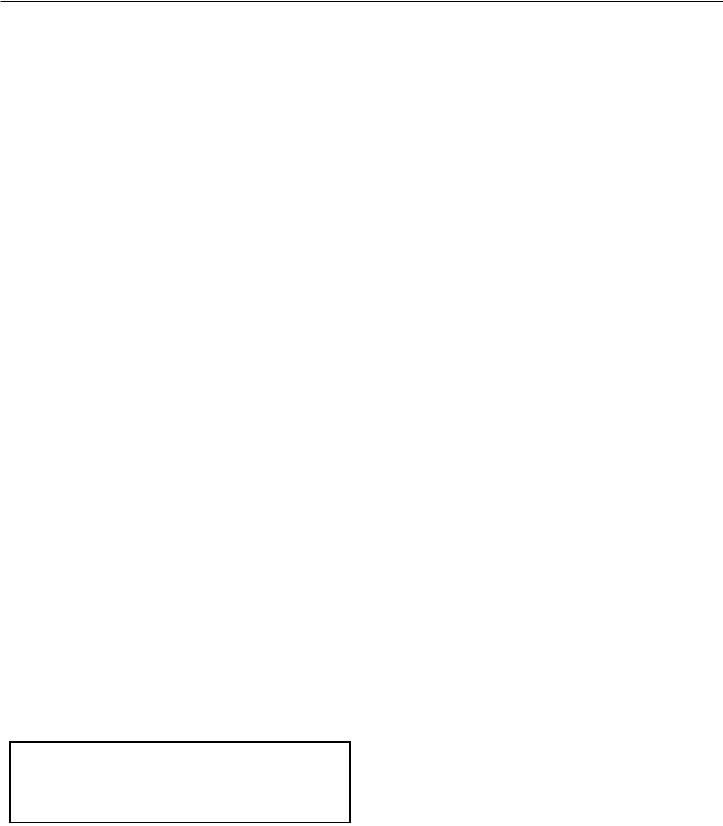
LOCATION REQUIREMENTS AND CONSIDERATIONS
A copy of the CAN/CSA B149 Installation Codes can also be obtained from:
CSA International
178 Rexdale Boulevard Etobicoke, Ontario, Canada M9W 1R3
The rated heating capacity of the furnace should be greater than or equal to the total heat loss of the area to be heated. The total heat loss should be calculated by an approved method or in accordance with “ASHRAE Guide” or “Manual J-Load Calculations” published by the Air Conditioning Contractors of America.
In the USA, this furnace MUST be installed in accordance with the latest edition of the ANSI Z223.1 booklet entitled “National Fuel Gas Code” (NFPA 54), and the requirements or codes of the local utility or other authority having jurisdiction. In Canada, this furnace must be installed in accordance with the current CAN/CGA-B149.1 & 2 Gas Installation Codes, local plumbing or waste water codes and other applicable codes. Additional helpful publications available from the NFPA are, NFPA 90A - Installation ofAir Conditioning and Ventilating System and NFPA 90B - Warm Air Heating and Air Conditioning System.
All venting shall be in accordance with PART 7, Venting of Equipment, of the National Fuel Gas Code, ANSI Z223.1, or applicable local building and/or air conditioning codes. These publications are available from:
National Fire Protection Association, Inc.
1 Batterymarch Park, Quincy, MA 02269
NOTE: Furnaces with NOx screens meet the California NOx emission standards and California seasonal efficiency standards. ANNUAL inspections of the furnace and its vent system is strongly recommended.
LOCATION REQUIREMENTS AND CONSIDERATIONS
Your unit model type determines which installation procedures must be used. For *MH8, *MS8, and GHS8 models, you must follow instructions for Horizontal Left, Horizontal Right or Upflow installations only. These furnaces are not approved for Downflow installations.
Downflow models GD(H,S) ARE NOT APPROVED FOR HORIZONTAL OR UPFLOW INSTALLATIONS. For these models, use only the instructions for downflow installation only.
 WARNING
WARNING
TO PREVENT POSSIBLE EQUIPMENT DAMAGE, PROPERTY DAMAGE,
PERSONAL INJURY OR DEATH, THE FOLLOWING BULLET POINTS MUST BE OBSERVED WHEN INSTALLING THIS UNIT.
Follow the instructions listed below when selecting a furnace location. Refer also to the guidelines provided in Section V, Combustion and Ventilation Air Requirements.
•Centrally locate the furnace with respect to the proposed or existing air distribution system.
•Ensure the temperature of the return air entering the furnace is between 55°F and 100°F when the furnace is heating.
•If the furnace is installed in an application where the typical operating sound level of a furnace is deemed objectionable, an optional sound reduction kit is available. Consult your local distributor for more details.
•Provisions must be made for venting combustion products outdoors through a proper venting system. The length of flue pipe could be a limiting factor in locating the furnace.
•Ensure adequate combustion air is available for the furnace. Improper or insufficient combustion air can expose building occupants to gas combustion products that could include carbon monoxide. Refer to Section V, Combustion and Ventilation Air Requirements.
•The furnace must be level. If the furnace is to be set on a floor that may become wet or damp at times, the furnace should be supported above the floor on a concrete base sized approximately 1-1/2" larger than the base of the furnace.
•Ensure upflow or horizontal furnaces are not installed directly on carpeting, or any other combustible material. The only combustible material allowed is wood.
•Exposure to contaminated combustion air will result in safety and performance-related problems. Do not install the furnace where the combustion air is exposed to the following substances:
chlorinated waxes or cleaners chlorine-based swimming pool chemicals water softening chemicals
deicing salts or chemicals carbon tetrachloride halogen type refrigerants
cleaning solutions (such as perchloroethylene) printing inks
paint removers varnishes hydrochloric acid cements and glues
antistatic fabric softeners for clothes dryers and masonry acid washing materials
•If the furnace is used in connection with a cooling unit, install the furnace upstream or in parallel with the cooling unit coil. Premature heat exchanger failure will result if the cooling unit coil is placed ahead of the furnace.
•If the furnace is installed in a residential garage, position the furnace so that the burners and ignition source are located not less than 18 inches (457 mm) above the floor. Protect the furnace from physical damage by vehicles.
•If the furnace is installed horizontally, the furnace access doors must be vertical so that the burners fire horizontally into the heat exchanger. Do not install the unit with the access doors on the “up/top” or “down/ bottom” side of the furnace.
8
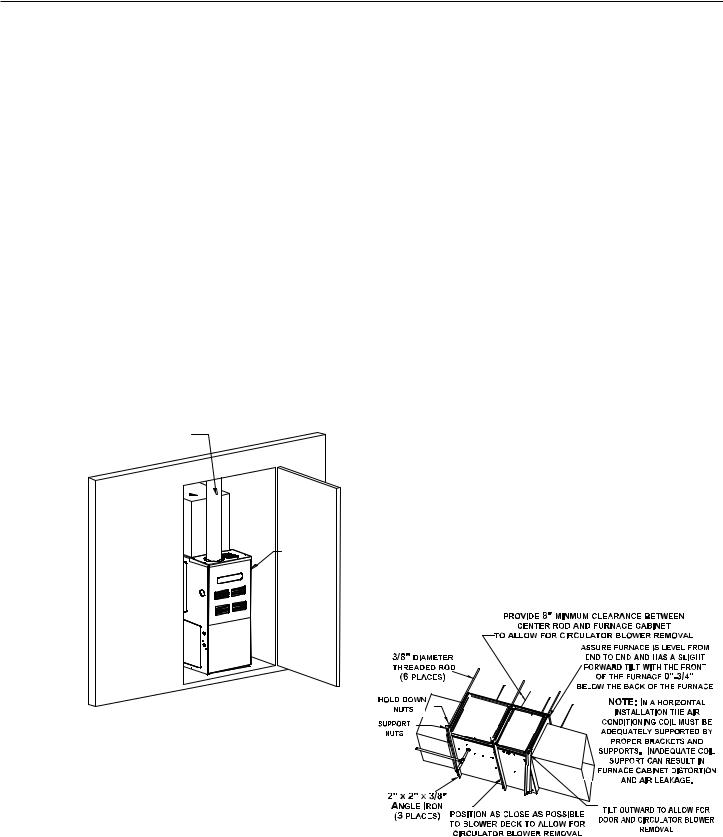
LOCATION REQUIREMENTS AND CONSIDERATIONS
•Do not connect this furnace to a chimney flue that serves a separate appliance designed to burn solid fuel.
•For counterflow installations, the air conditioning coil must be downstream from the heat exchanger of the furnace.
•Counterflow installation over a noncombustible floor. Before setting the furnace over the plenum opening, ensure the surface around the opening is smooth and level. A tight seal should be made between the furnace base and floor by using a silicon rubber caulking compound or cement grout.
•Counterflow installation over a combustible floor. If installation over a combustible floor becomes necessary, use an accessory subbase (see Specification Sheet applicable to your model for details). A special accessory subbase must be used for upright counterflow unit installations over any combustible material including wood. Follow the instructions with the subbase for proper installations. Do not install the furnace directly on carpeting, tile, or other combustible material other than wood flooring. (NOTE: The subbase will not be required if an air conditioning coil is installed between the supply air opening on the furnace and the floor.
Vent Pipe Clearance to Combustibles- 6" using Single Wall Connector or 1" using B-1 vent.
Top - 1" 
Back - 0"
Side
Clearance - 1"
Front Clearance - 3"
•Adequate combustion/ventilation air must be supplied to the closet.
•Furnace must be completely sealed to floor or base. Combustion/ ventilation air supply pipes must terminate 12" from top of closet and 12" from floor of closet. DO NOT remove solid base plate for side return.
•Return air ducts must be completely sealed to the furnace and terminate outside the enclosure surfaces.
CLEARANCES AND ACCESSIBILITY
Unobstructed front clearance of 24" for servicing is recommended.
|
VEN T |
SIDES |
FRON T |
BAC K |
TOP |
||
B1-VENT |
SINGLE |
(PLENUM ) |
|||||
|
|
|
|||||
1" |
|
6" |
1" |
3" |
0" |
1" |
|
|
|
|
|
|
|
|
|
Top clearance for horizontal configuration - 1"
INSTALLATION POSITIONS
An upflow furnace may be installed in an upright position or horizontal on either the left or right side panel. Do not install this furnace on its back. For vertically installed upflow furnaces, return air ductwork may be attached to the side panel(s) and/ or basepan. For horizontally installed upflow furnaces, return air ductwork must be attached to the basepan. For counterflow furnaces, return ductwork must be attached to the top end of the blower compartment.
NOTE: Ductwork must never be attached to the back of the furnace.
HORIZONTALINSTALLATION
Line contact to framing is permitted when installed in the horizontal configuration. Line contact is defined as the portion of the cabinet that is formed by the intersection of the top and side. ACCESSIBILITY CLEARANCE, WHERE GREATER, SHOULD TAKE PRECEDENCE OVER MINIMUM FIRE PROTECTION CLEARANCE. A gas-fired furnace for installation in a residential garage must be installed so that the ignition source and burners are located not less than eighteen inches (18") above the floor and is protected or located to prevent physical damage by vehicles. A gas furnace must not be installed directly on carpeting, tile, or other combustible materials other than wood flooring.
FURNACESUSPENSION
If suspending the furnace from rafters or joist, use 3/8" threaded rod and 2”x2”x3/8” angle iron as shown below. The length of rod will depend on the application and the clearances necessary.
Suspended Furnace
9
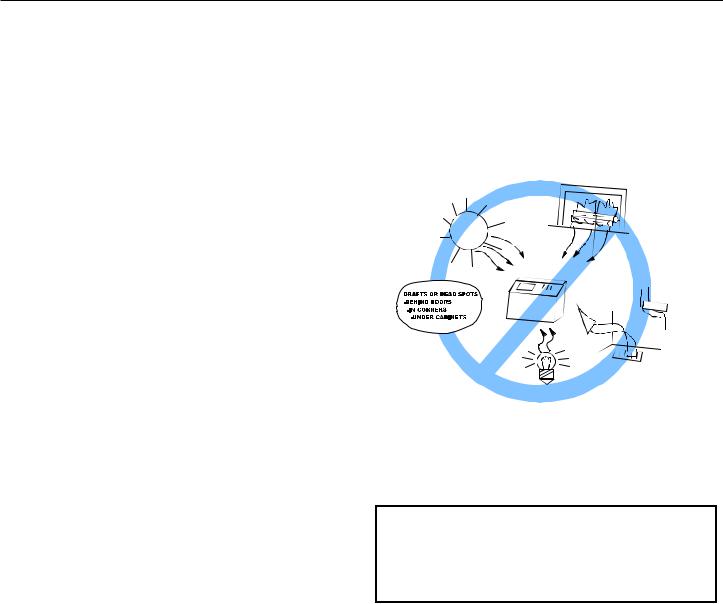
COMBUSTION & VENTILATION CATEGORY I VENTING AIR REQUIREMENTS
EXISTING FURNACE REMOVAL
NOTE: When an existing furnace is removed from a venting system serving other appliances, the venting system may be too large to properly vent the remaining attached appliances.
The following vent testing procedure is reproduced from the
American National Standard/National Standard of Canada for Gas-Fired Central Furnaces ANSI Z21.47-Latest Edition, CSA-2.3-Latest Edition Section 1.23.1. The following steps shall be followed with each appliance connected to the venting system placed in operation, while any other appliances connected to the venting system are not in operation:
a.Seal any unused openings in the venting system;
b.Inspect the venting system for proper size and horizontal pitch, as required by the National Fuel Gas Code, ANSI Z223.1 or the CAN/CSA B149 Installation Codes and these instructions. Determine that there is no blockage or restriction, leakage, corrosion and other deficiencies which could cause an unsafe condition;
c.In so far as practical, close all building doors and windows and all doors between the space in which the appliance(s) connected to the venting system are located and other spaces of the building. Turn on clothes dryers and any appliance not connected to the venting system. Turn on any exhaust fans, such as range hoods and bathroom exhausts, so they shall operate at maximum speed. Do not operate a summer exhaust fan. Close fireplace dampers;
d.Follow the lighting instructions. Place the appliance being inspected in operation. Adjust thermostat so appliance shall operate continuously;
e.Test for draft hood equipped appliance spillage at the draft hood relief opening after 5 minutes of main burner operation. Use the flame of a match or candle;
f.After it has been determined that each appliance connected to the venting system properly vents when tested as outlined above, return doors, windows, exhaust fans, fireplace dampers and any other gas burning appliance to their previous conditions of use;
g.If improper venting is observed during any of the above tests, the common venting system must be corrected.
Corrections must be in accordance with the latest edition of the National Fuel Gas Code NFPA54/ANSI Z223.1 and/or CAN/ CSA B149 Installation Codes.
If resizing is required on any portion of the venting system, use the appropriate table in Appendix G in the latest edition of the National Fuel Gas Code ANSI Z223.1 and/or CAN/CSA B149 Installation Codes.
THERMOSTAT LOCATION
In an area having good air circulation, locate the thermostat about five feet high on a vibration-free inside wall. Do not install the thermostat where it may be influenced by any of the following:
•Drafts, or dead spots behind doors, in corners, or under cabinets.
•Hot or cold air from registers.
•Radiant heat from the sun.
•Light fixtures or other appliances.
•Radiant heat from a fireplace.
•Concealed hot or cold water pipes, or chimneys.
•Unconditioned areas behind the thermostat, such as an outside wall.
 HOT
HOT
 COLD
COLD
Thermostat Influences
Consult the instructions packaged with the thermostat for mounting instructions and further precautions.
COMBUSTION AND VENTILATION AIR REQUIREMENTS
 WARNING
WARNING
TO AVOID PROPERTY DAMAGE, PERSONAL INJURY OR DEATH,
SUFFICIENT FRESH AIR FOR PROPER COMBUSTION AND VENTILATION OF FLUE GASES MUST BE SUPPLIED. MOST HOMES REQUIRE OUTSIDE AIR BE SUPPLIED INTO THE FURNACE AREA.
Improved construction and additional insulation in buildings have reduced heat loss by reducing air infiltration and escape around doors and windows. These changes have helped in reducing heating/cooling costs but have created a problem supplying combustion and ventilation air for gas fired and other fuel burning appliances. Appliances that pull air out of the house (clothes dryers, exhaust fans, fireplaces, etc.) increase the problem by starving appliances for air.
House depressurization can cause back drafting or improper combustion of gas-fired appliances, thereby exposing building occupants to gas combustion products that could include carbon monoxide.
If this furnace is to be installed in the same space with other gas appliances, such as a water heater, ensure there is an adequate supply of combustion and ventilation air for the other appliances. Refer to the latest edition of the National Fuel Gas
10
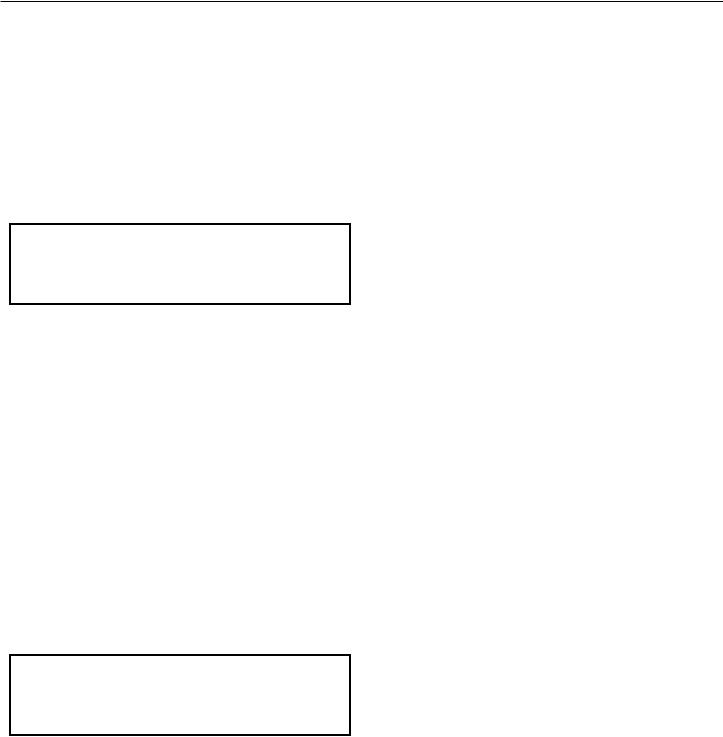
EXTERIOR MASONRY CHIMNEYS - CATEGORY I FURNACES ONLY
Code NFPA 54/ANSI Z223.1 or CAN/CSA B149 Installation Codes or applicable provisions of the local building codes for determining the combustion air requirements for the appliances.
This furnace must use indoor air for combustion. It cannot be installed as a direct vent (i.e., sealed combustion) furnace.
Most homes will require outside air be supplied to the furnace area by means of ventilation grilles or ducts connecting directly to the outdoors or spaces open to the outdoors such as attics or crawl spaces.
CATEGORY I VENTING (VERTICAL VENTING)
 WARNING
WARNING
TO PREVENT POSSIBLE PERSONAL INJURY OR DEATH DUE TO ASPHYXIATION, THIS FURNACE MUST BE CATEGORY I VENTED. DO NOT VENT USING CATEGORY III VENTING.
Category I Venting is venting at a non-positive pressure. A furnace vented as Category I is considered a fan-assisted appliance and the vent system does not have to be “gas tight.” NOTE: Single stage gas furnaces with induced draft blowers draw products of combustion through a heat exchanger allowing, in some instances, common venting with natural draft appliances (i.e. water heaters). All installations must be vented in accordance with National Fuel Gas Code NFPA54/ANSI Z223.1 - latest edition. In Canada, the furnaces must be vented in accordance with the National Standard of Canada, CAN/CSA B149.1 and CAN/CSA B149.2 - latest editions and amendments.
NOTE: Masonry vent kit (MVK-01 and MVK-02) is to only be used on interior masonry chimneys or qualifying exterior masonry chimney applications identified in the MVK kit installation instructions. To ensure safe and reliable operation, use only the kit listed for your model.
NOTE: The vertical height of the Category I venting system must be at least as great as the horizontal length of the venting system.
 WARNING
WARNING
TO PREVENT POSSIBLE PERSONAL INJURY OR DEATH DUE TO ASPHYXIATION, COMMON VENTING WITH OTHER MANUFACTURER’S INDUCED DRAFT APPLIANCES IS NOT ALLOWED.
The minimum vent diameter for the Category I venting system is as shown:
MODEL |
MINIMUM VENT |
||
UPFLOW |
COUNTERFLOW |
||
|
|||
40 |
4 Inch |
4 Inch |
|
60 |
4 Inch |
4 Inch |
|
80 |
4 Inch |
4 Inch |
|
100 |
5 Inch |
5 Inch |
|
120 |
5 Inch |
N/A |
|
140 |
5 Inch |
N/A |
|
Under some conditions, larger vents than those shown above may be required or allowed. When an existing furnace is removed from a venting system serving other appliances, the venting system may be too large to properly vent the remaining attached appliances.
Upflow or Horizontal units are shipped with the induced draft blower discharging from the top of the furnace. (“Top” is as viewed for an upflow installation.) The induced draft blower can be rotated 90 degrees with the (0270F01119) chimney transition bottom kit for Category I venting. For horizontal installations, a four inch single wall pipe can be used to extend the induced draft blower outlet 1/2” beyond the furnace cabinet.
THIS PRODUCT IS NOT DESIGNED FOR COUNTERCLOCKWISE INDUCED DRAFT BLOWER ROTATION.
Vent the furnace in accordance with the National Fuel Gas Code NFPA 54/ANSI Z223.1 - latest edition. In Canada, vent the furnace in accordance with the National Standard of Canada, CAN/CSA B149.1 and CAN/CSA B149.2 - latest editions and amendments.
Venting - Furnace Installed in Horizontal Position
THIS FURNACE IS NOT DESIGN CERTIFIED TO BE HORIZONTALLY VENTED THROUGH AN EXTERIOR SIDE WALL.
The following describes an optional venting procedure when the furnace is installed in the horizontal left discharge position.
To rotate the induced draft blower clockwise, you will need to purchase one (0270F01119) chimney transition bottom kit.
1.Disconnect electrical power from the furnace.
2.Disconnect the induced draft blower power leads, flue pipe, and pressure switch tubing.
3.Remove the round cutout from the right side of the wrapper.
4.Remove and save the four screws that fasten the induced draft blower to the flue collector box.
5.Remove and save the three screws that hold the chimney assembly to the induced draft blower.
6.Remove and save the four screws that fasten the chimney top to the chimney bottom.
7.Remove the chimney transition bottom from the transition bottom kit.
8.Install the chimney top with the four screws retained from step 6 onto the new chimney transition bottom from the transition bottom kit.
9.Remove the induced draft blower and install the new chimney assembly to it using the three screws retained from step 5.
10.Rotate the induced draft blower 90 degrees to the right, feed the flue pipe through the round cutout from the outside of the wrapper, and fit onto the chimney top assembly. Secure the pipe to the chimney top from the front, top, and bottom using (3) screws and rotating the induced
11
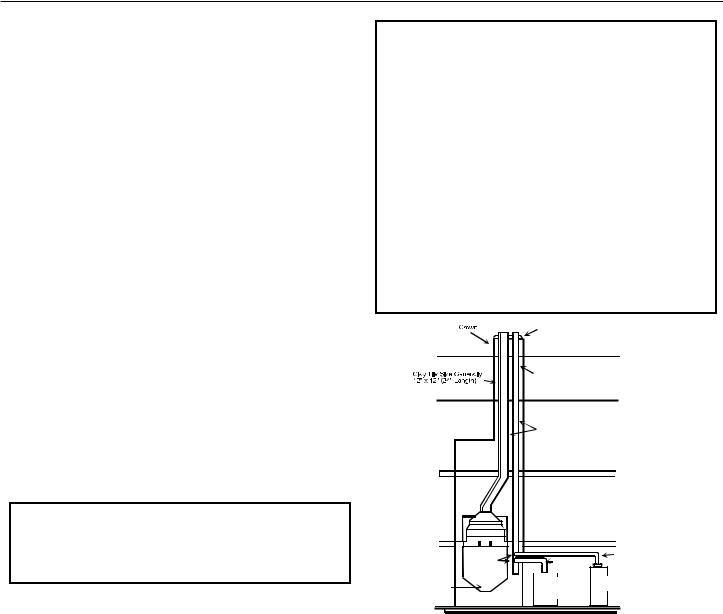
EXTERIOR MASONRY CHIMNEYS - CATEGORY I FURNACES ONLY
draft blower to properly orient the assembly. NOTE: If the pipe section is less than 18”, then attach it directly to the chimney top on 3 sides and feed it through the round cutout from the inside of the wrapper.
11.Reattach the induced draft blower using the (4) screws retained from step 3. Ensure the gasket located between the induced draft blower and collector box is rotated accordingly.
12.Reconnect the induced draft blower power leads. NOTE: If the wires are not long enough, pull extra wire from the wire bundle in the blower compartment.
13.Reconnect the remaining flue pipe, and the pressure switch tubing. Ensure that all wires and the pressure switch tubing is at least one inch from the flue pipe, or any other hot surface.
14.Restore power to furnace.
NOTE: In a horizontal installation the air conditioning coil must be adequately supported by proper brackets and supports. Inadequate coil support can result in furnace cabinet distortion and air leakage.
Counterflow units are shipped with the induced draft blower discharging from the top of the furnace. (“Top” as viewed for a counterflow installation.)
Vent the furnace in accordance with the National Fuel Gas Code NFPA54/ANSI Z223.1-latest edition. In Canada, vent the furnace in accordance with the national standard of Canada, CAN/CSA B149.1 and CAN/CSA B149.2- latest editions and amendments.
 WARNING
WARNING
NEVER ALLOW THE PRODUCTS OF COMBUSTION, INCLUDING CARBON MONOXIDE, TO ENTER THE RETURN DUCTWORK OR CIRCULATION AIR SUPPLY.
EXTERIORMASONRYCHIMNEYS (CATEGORYIFURNACESONLY)
An exterior masonry chimney is defined as a “Masonry” chimney exposed to the outdoors on one or more sides below the roof line.” The ability to use a clay lined masonry chimney depends on a parameter not associated with interior chimneys. This variable is the geographic location of the installation. Researchers have discovered that the winter design temperatures have a direct impact on the suitability of this type of venting. In most situations, the existing masonry chimneys will require a properly sized metallic liner.
 WARNING
WARNING
POSSIBILITY OF PROPERTY DAMAGE, PERSONAL INJURY OR DEATH DAMAGING CONDENSATION CAN OCCUR INSIDE MASONRY CHIMNEYS WHEN A SINGLE FAN ASSISTED CATEGORY I APPLIANCE (80% AFUE
FURNACE) IS VENTED WITHOUT ADEQUATE DILUTION AIR. DO NOT CONNECT AN 80% FURNACE TO A MASONRY CHIMNEY UNLESS THE FURNACE IS COMMON VENTED WITH A DRAFT HOOD EQUIPPED APPLIANCE OR THE CHIMNEY IS LINED WITH A METAL LINER OR TYPE B
METAL VENT. ALL INSTALLATIONS USING MASONRY CHIMNEYS MUST BE SIZED IN ACCORDANCE WITH THE APPROPRIATE VENTING TABLES. IF AN
80% FURNACE IS COMMON VENTED WITH A DRAFT HOOD EQUIPPED APPLIANCE, THE POTENTIAL FOR CONDENSATION DAMAGE MAY STILL EXIST WITH EXTREMELY COLD CONDITIONS, LONG VENT CONNECTORS,
EXTERIOR CHIMNEYS, OR ANY COMBINATION OF THESE CONDITIONS. THE RISK OF CONDENSATION DAMAGE IS BEST AVOIDED BY USING MASONRY CHIMNEY AS A PATHWAY FOR PROPERLY SIZED METAL LINER OR TYPE B METAL VENT.
|
Wash |
|
|
|
Roof Line |
|
Clay Tile Size: 8" x 8" x12" |
|
|
(Each x 24" Length) |
|
|
|
Attic Floor |
|
1/2" to 1" Air Space |
|
|
Second Floor |
|
Throat |
|
|
Damper |
|
|
|
|
First Floor |
|
|
Water Heater |
Breech |
F.A.F. Vent |
Vent Connector |
|
Connector |
|
|
|
|
|
|
|
|
|
|
|
|
|
Fan Assisted |
|
Natural Draft |
|
Clean Out |
|
|
|
Forced Air |
|
Water Heater |
|
|
|
|
|
Furnace |
|
|
|
|
|
|
|
|
|
|
|
Basement Floor
Typical Multiple Flue Clay Tile Chimney
CHECKLIST SUMMARY
This checklist serves as a summary of the items to be checked before venting an 80+ furnace into a masonry chimney. In addition, we recommend that a qualified serviceman use this checklist to perform a yearly inspection of the furnace venting system.
This checklist is only a summary. For detailed information on each of the procedures mentioned, see the paragraph referenced with each item.
This inspection is based upon a draft topical report, “Masonry Chimney Inspection and Relining”, issued by the Gas Research Institute. While not yet finalized, we believe this report represents the best information on this subject which is currently available.
12
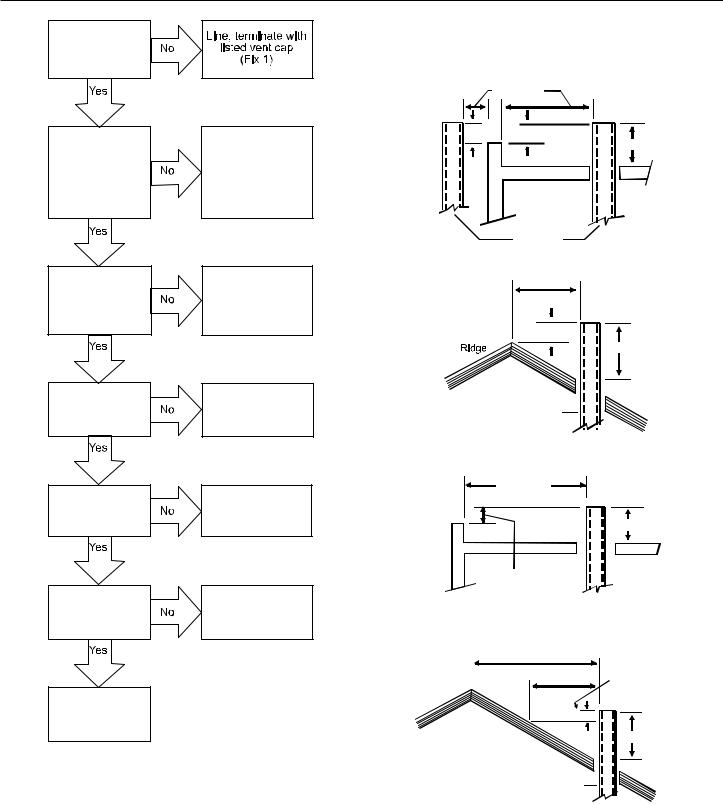
EXTERIOR MASONRY CHIMNEYS - CATEGORY I FURNACES ONLY
Proper Chimney
Termination?
(Check 1)
Chimney channel free of solid and liquid fuel appliances? (Check 2)
Crown in good condition (Check 3)
Cleanout free of debris?
(Check 4)
Liner in good condition? (Check 5)
Dilution air available? (Check 6)
Complete the installation. (Check 7)
Change venting arrangements (Fix 2)
Rebuild crown (Fix 3) and/or Reline (Fix 4)
Reline (Fix 4)
Reline (Fix 4)
Reline (Fix 4)
CHECK 1 -PROPER CHIMNEY TERMINATION.
A masonry chimney used as a vent for gas fired equipment must extend at least three feet above the highest point where it passes through the roof. It must extend at least two feet higher than any portion of a building within a horizontal distance of 10 feet. In addition, the chimney must terminate at least 3 feet above any forced air inlet located within 10 feet. The chimney must extend at least five feet above the highest connected equipment draft hood outlet or flue collar.
If the chimney does not meet these termination requirements, but all other requirements in the checklist can be met, it may be possible for a mason to extend the chimney. If this will not be practical, see Fix 1.
|
10' or Less |
2' Min. |
2' Min. |
3' Min.
Wall or
Parapet
 Chimney
Chimney
10' or Less
2' Min.
3' Min.
Chimney
Termination 10 Feet Or Less From Ridge, Wall or Parapet
More than 10’
3’ Min.
|
NOTE: No Height |
|||||
|
above parapet |
|||||
Wall or |
required when distance |
|||||
from walls or parapet is |
||||||
Parapet |
||||||
more than 10 feet. |
||||||
|
||||||
|
|
|
|
|
|
|
|
|
More than 10’ |
|
|
||
|
|
|
|
|
|
|
|
|
|
|
|
||
Ridge |
|
|
|
10’ |
||
|
|
|
|
|
||
2” Min.
Chimney
Chimney
Height above any roof surface within 10 feet horizontally.
3’ Min.
Termination More Than 10 Feet From Ridge, Wall or Parapet
CHECK 2-ANY SOLID OR LIQUID FUEL APPLIANCES VENTED INTO THIS CHIMNEY CHANNEL
Solid fuel appliances include fireplaces, wood stoves, coal furnaces, and incinerators.
13

EXTERIOR MASONRY CHIMNEYS - CATEGORY I FURNACES ONLY
Liquid fuel appliances include oil furnaces, oil-fired boilers and oil-fired water heaters.
Appliances which burn propane (sometimes referred to as LP (liquefied petroleum)) gas are considered gas-fired appliances.
CHECK 3-CHIMNEY CROWN CONDITION.
Damage from condensate usually shows up first in the crown. If any of the following trouble signs are present, the condition of the crown is not satisfactory:
a)Crown leaning
b)Bricks missing
c)Mortar missing
d)Tile liner cracked
e)No tile liner
f)Salt staining at mortar joints. (White stains, and mortar becomes sandy and/or erodes.)
For problems a, b, or c, see Fix 3. If problems d, e, or f are present, see Fix 4. IMPORTANT: It may be necessary to follow both Fix 3 and Fix 4.
CHECK 4-DEBRIS IN CLEANOUT
A cleanout (dropleg) must be present such that the upper edge of the cleanout cover is at least 12 inches below the lower edge of the lowest chimney inlet opening.
A chimney without a cleanout could become partially blocked by debris. If no cleanout is present, the chimney must be relined (Fix 4). Remove the cleanout cover, and examine the cleanout for debris. If significant amounts of any of the following are found:
•Fuel oil residue
•Bricks
•Mortar or sand
•Pieces of the tile liner
•Rusted pieces of the metallic liner - reline the chimney (Fix 4).
CHECK 5-LINER CONDITION.
If a metal liner is present, it must be checked. It cannot be assumed that all existing metal liners are correctly installed and in good condition.
Remove the lowest existing vent connector, and examine the inside of the elbow or tee at the base of the liner. Asmall amount of soot may be considered acceptable, provided the installer vacuums it away. If rusted pieces of the liner have collected here, the metal liner must be removed and replaced (Fix 4).
Next, gently tap the inside of the liner with a Phillips screwdriver. If the screwdriver perforates the liner, or if the tapping does not sound like metal hitting metal, the liner must be removed and replaced (Fix 4).
Remember that all appliances must be vented inside the liner. Venting one appliance inside the liner and another appliance outside the liner is not acceptable.
Next, use a flashlight and small mirror to sight up the liner. B vent must be supported so as to not come into direct contact with the chimney walls or tile liner. If it is not, it can probably be rehung so as to be acceptable. A thimble or fire stop may be helpful here.
Flexible liners should be hung straight or nearly straight. If it is spiraled in the chimney and in good condition, it should be rehung. To do this, break the top seal; pull up and cut off the excess liner length, and refit the top seal. Use caution when doing this, as the cut edges of flexible liners may be sharp.
The surfaces of the liner must be physically sound. If gaps or holes are present, the metal liner must be removed and replaced (Fix 4). Finally, confirm that the metal liner is the correct size for the appliances to be installed. Use the GAMA tables and rules.
If a metal liner is not present, a clay tile liner must be present, or the chimney must be lined (Fix 4).
Use a flashlight and small mirror at the cleanout or vent connector to inspect the clay tile liner. If any of the following problems are present:
•Tile sections misaligned
•Tile sections missing
•Gaps between tile sections
•Signs of condensate drainage at the cleanout or vent connectors
•Mortar protruding from between tile sections
•Use of sewer pipe or drainage pipe rather than an approved fire clay tile reline the chimney (Fix 4).
Next, measure the size of the liner. It may be possible to do this from the cleanout. The liner must be at least as large as the minimum size established by the tables in National Fuel Gas Code NFPA 54/ANSI Z223.1 - latest edition and in the National Standard of Canada, CAN/CSA B149.1 and CAN/CSA B149.2 - latest editions and amendments. If the liner is too small or too large, then the chimney must be relined (Fix 4).
CHECK 6 - DILUTION AIR.
If gas-fired appliances are to be vented into a clay tile liner, a source of dilution air is required.
Dilution air cannot be obtained through:
•Induced draft appliances
•Natural draft appliances with vent dampers
Sufficient dilution air can ordinarily be obtained through the draft hood of a natural draft appliance only if the appliance’s vent connector does not include a vent damper. If dilution air will not be available, the chimney must be relined (Fix 4).
14

EXTERIOR MASONRY CHIMNEYS - CATEGORY I FURNACES ONLY
CHECK 7 - COMPLETE THE INSTALLATION. |
FIX 3 - REBUILD THE CROWN |
If Checks 1 through 6 have been satisfactory, and the liner is an acceptable size as determined by the tables in National Fuel Gas Code NFPA 54/ANSI Z223.1 - latest edition and in the National Standard of Canada, CAN/CSA B149.1 and CAN/CSA B149.2 - latest editions and amendments, then the clay tile liner can probably be used as a vent for the gas appliances. However, the installer must keep in mind the following factors which may render the tile liner unsuitable for use as a vent:
•Extremely cold weather
•Long vent connectors
•Masonry chimneys with no air gap between the liner and the bricks. (In practice, this can be difficult to detect.)
•Exterior chimneys (The tables in National Fuel Gas Code NFPA 54/ANSI Z223.1 - latest edition and in the National Standard of Canada, CAN/CSA B149.1 and CAN/CSA B149.2 - latest editions and amendments assume interior chimneys.)
If, in the judgment of the local gas utility, installer, and/or local codes; one or more of the above factors is likely to present a problem, the chimney must be relined (Fix 4).
FIX 1 - LINER TERMINATION
Any cap or roof assembly used with a liner must be approved by the liner manufacturer for such use. The liner and cap/roof assembly must then terminate above the roof in accordance with the manufacturer’s instructions.
In some cases, a shorter extension above the roof may be possible with a liner than would be required with a masonry chimney.
For further information on relining, see Fix 4.
FIX 2-CHANGE VENTING ARRANGEMENTS
If the masonry chimney has more than one channel, it may be possible to vent the gas appliances into one channel and vent the solid or liquid fuel appliance(s) into another channel(s). Do not vent an 80+ Furnace inside of a metal liner with other appliances vented outside the liner.
Alternatively, the homeowner may agree to discontinue use of the fireplace (solid fuel appliance). If so, the tile liner must be cleaned to remove creosote buildup. The fireplace opening must then be permanently sealed.
If oil-fired appliance(s) are being replaced by gas-fired appliance(s), the tile liner must first be cleaned to remove the fuel oil residue.
If none of the above options is practical, the furnace may need to be vented vertically with a B Vent.
Under some conditions, a 90%+ furnace could be installed rather than an 80% furnace. The 90%+ furnace can be vented horizontally or vertically through PVC pipe.
If the chimney crown is damaged, a qualified mason must repair it in accordance with nationally recognized building codes or standards. One such standard which may be referenced is the Standard for Chimneys, Fireplaces, Vents, and Solid Fuel Burning Appliances, ANSI/NFPA 211.
FIX 4 - RELINING
Relining options include B vent and flexible liners.
If the chimney has diagonal offsets, B vent probably cannot be used.
If B vent is to be used, it must be supported adequately. Supports (such as fire stops or thimbles) must be used to prevent the B vent from coming into direct contact with the tile liner or chimney walls. Direct contact would result in higher heat loss, with an increased possibility of poor venting system performance.
It is not acceptable to vent one appliance inside the B vent and other appliances outside. The excess space between the B vent and the chimney walls must be covered at the top of the chimney by a weatherproof, corrosion resistant flashing.
The B vent should then be topped with a listed vent cap. The listed vent cap will, when installed per the manufacturer’s instructions, prevent problems due to rain, birds, or wind effects.
A B-vent installed as described in this section is considered to be an enclosed vent system, and the sizing tables in National Fuel Gas Code NFPA 54/ANSI Z223.1 - latest edition and in the National Standard of Canada, CAN/CSA B149.1 and CAN/ CSA B149.2 - latest editions and amendments may be used.
If a flexible liner is to be used, it must be made of the proper materials:
•For most residential applications, an aluminum liner should be acceptable.
•If the combustion air supplied to the furnace will be contaminated with compounds containing chlorine or fluorine, a liner of AL 29-4C stainless steel should be used. Common sources of chlorine and fluorine compounds include indoor swimming pools and chlorine bleaches, paint strippers, adhesives, paints, varnishes, sealers, waxes (which are not yet dried) and solvents used during construction and remodeling. Various commercial and industrial processes may also be sources of chlorine/fluorine compounds.
•Heavier gauge 300 and 400 series stainless steel liners were developed for use with oil or solid fuel appliances. They are not suitable for use with gas-fired appliances. Flexible liners specifically intended and tested for gas applications are listed in the UL “Gas and Oil Equipment Directory”. (UL Standard 1777).
15
